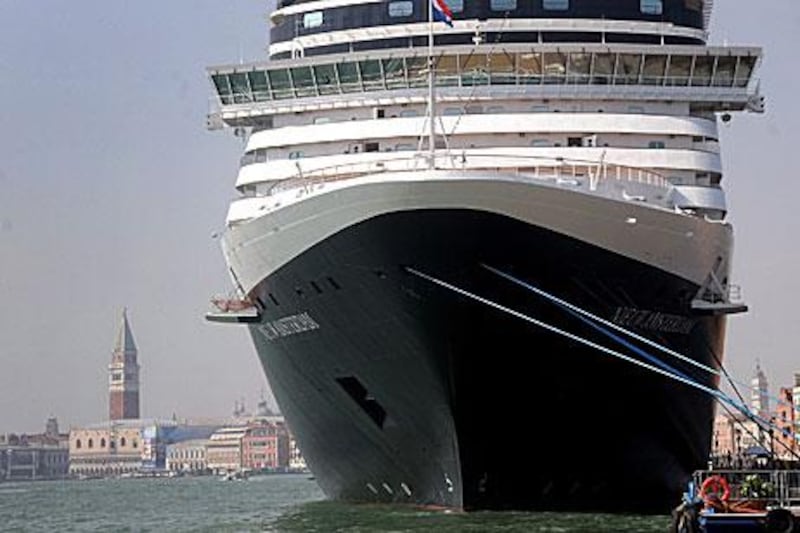VENICE, ITALY // It is a matter of perspective. From aboard a 12-deck cruise liner, the sight of St Mark's Square, the Doge's Palace and Bridge of Sighs gliding past a cabin balcony is a breathtaking thrill.
But against the backdrop of Venice's storied canals and Byzantine architecture, these floating condominiums present a jarring sight, out of scale and sync with the surroundings.
The fatal grounding of the Costa Concordia off the Tuscan coast has sharpened the focus on the largely unchecked boom of these ever-larger luxury liners, and nowhere more so than in Venice, a fragile city already struggling against mass tourism and the steady deterioration of its underwater foundations.
There is growing clamour for an urgent rethink to the expanding cruise liner traffic through Venice's historic centre. Critics point not only to a threat of accidents, but also air and water pollution, and the injection of an additional two million more tourists a year into a city already under constant siege.
The city wants to reroute cruise ships arriving in Venice so they stay farther from St Mark's and other prominent monuments as a possible step toward keeping them out of the lagoon altogether. And Unesco, the United Nations' culture organisation, charges that the liners cause water tides that erode building foundations and pollute waterways.
Venice in the space of 15 years has become one of the world's most important cruise destinations, the port serving as a lucrative turnaround point for 650 cruises a year - up to nine a day in high season. Since 1997, the number of passengers cruising through Venice has risen from 280,000 to 1.8 million last year.
"One third of all cruise ships worldwide come to Venice each year," said Roberto Perocchio, the managing director of the Venice passenger terminal, which manages cruise traffic in the lagoon.
He expects the appetite for cruising to continue to grow, citing forecasts that the 5 million annual cruise passengers a year in Europe is expected to double by 2020.
If the cruise ships were modern buildings, which they strongly resemble, they would certainly not be allowed in Venice, a Unesco heritage site that mandates the view of protected places cannot be permanently altered. But because they move, there is no official sanction against them.
Just a day after the grounding of the Costa Concordia, dozens of protesters demonstrated as an MSC cruise liner sailed across the St Mark's basin. Grass-roots opposition to the luxury liners predates the Costa disaster, but it has taken new impetus.
"Venice is too often on its knees in front of the gods of economy and tourism, and we have been paying the consequences for years. The city has been emptied of its residents, and it is a victim of pollution from this unsustainable traffic," said Saverio Pastor, a craftsman who makes oarlocks for gondolas and who has been leading the campaign to rid the Venice basin of cruise ships.
Studies commissioned by the port authority show that the cruise liners are responsible for up to 30 per cent of the city's air pollution.
Residents along the Giudecca canal, the wide waterway through which the ships pass en route to their berths, complain both about the noise and the impact of water being pushed up into the narrower feeder canals, eroding foundations as the water surges and recedes.
"One woman told me that when the ships pass, water from the canals backs up into her toilet," said Jane da Mosto, a long-time Venice resident and scientist for the London-based Venice in Peril association.






